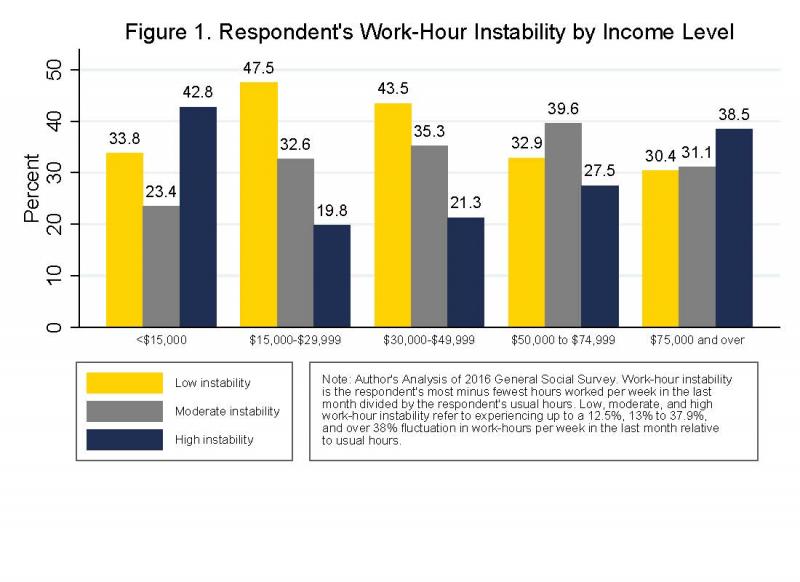Unstable Work Schedules and Earnings Volatility
By Savannah Hunter, UC Davis
Unstable work schedules include work hours that are variable, meaning the number of hours worked week to week fluctuates, and unpredictable, meaning workers receive little notice of when they will work. Such schedules are common in the United States and lead to earnings volatility, unpredictable incomes, and challenges in work-family management. For low-income workers, these problems may be magnified as almost 43 percent of workers making under $15,000 experience high work-hour instability and 57 percent report high schedule unpredictability.
While measures differ, many workers in the U.S. face variable work hours.
When asked to provide their usual hours worked per week, around 7 percent of working adults say their work hours vary. However, when explicitly asked if hours vary, 55 percent of workers say yes.[1] When asked to report their most and least hours worked in a month, 81 percent of workers (in 2016) reported work-hour fluctuations, with typical variations of about 15 hours per week.[2] Among hourly workers aged 26 to 32, 74 percent report work-hour fluctuations.[3]
Work-hour variability differs over time and by industry, sector, employment status, and education.
The probability of reporting work-hour variability from 2004 to 2007 was 36 percent. During and after the Great Recession (2008-2012), the probability of reporting work-hour variability was 46 percent.[4] In 2014, the majority of workers in agriculture, food service, retail, and construction reported hours that varied across weeks.[1] Part-time workers report their work hours vary at a rate 2.5 times higher than that reported by full-time workers.[1] Varying hours are more common for workers in the private sector, workers with short job tenure, and workers without a high school degree.[4]
Unpredictable work schedules are also common, especially for hourly workers, part-time workers, and workers in the retail and service sectors.
In 2016, 37 percent of U.S. workers reported receiving one week or less notice of their work schedule, with higher rates among part-time and hourly workers.[2] Such unpredictable work schedules are especially common in the retail and service industries, with 48 percent of service workers receiving one week or less notice of their schedules.[3] Indeed, among workers at the 15 largest retailers in the U.S., 19 percent receive less than one week’s notice, while 42 percent receive between one and two weeks’ notice.[5]
Both variable and unpredictable work schedules lead to earnings volatility and unpredictability in take-home pay.[4,6]
In 2013, 31 percent of American workers experienced income irregularity, with 42 percent of them attributing the irregularity to unstable work schedules.[7] Relatedly, high earnings volatility is more prevalent among those who commonly experience varying work hours.[4] Earnings in the service sector are especially volatile due to high prevalence of unstable work schedules. For example, a typical service worker at one of the largest retail and fast-food companies in 2016 had average weekly earnings fluctuations of $137, or close to 50 percent of their weekly earnings.[6]
Workers on the edge of poverty are often subject to variable and unpredictable work hours and are the least equipped to absorb the financial impact of irregular earnings.[8]
Workers with varying hours earn less than those with stable schedules and have higher rates of poverty.[9] Almost 43 percent of workers who make under $15,000 per year experience high work-hour instability (see Figure 1).[2] Meanwhile, workers making under $15,000 also experience more schedule unpredictability than workers in higher income brackets, with 57 percent receiving one week or less of schedule notice.[2] Such variable hours increase the difficulty of paying bills[5], budgeting, saving, and supplementing income by working a second job, further trapping low-wage workers in a cycle of poverty.[8]
 References
References
1. Golden, L. (2016). Still Falling Short on Hours and Pay: Part-time Work Becoming New Normal. Economic Policy Institute.
2. Hunter, S. (Unpublished). The Scheduling Dilemma: Unstable Work Schedules and Perceptions of Job Security.
3. Lambert, S., Fugiel, P., & Henly, J. (2014). Precarious Work Schedules Among Early Career Employees in the US: A National Snapshot. Employment Instability, Family Well-being, and Social Policy Network.
4. Finnigan, R. (2018). Varying weekly work hours and earnings instability in the Great Recession. Social Science Research.
5. Schneider, D., & Harknett, K. (2016). Schedule Instability and Unpredictability and Worker and Family Health and Well-being. Report: Washington Center for Equitable Growth, 1-48.
6. Schneider, D., & Harknett, K. (2017). Income Volatility in the Service Sector: Contours, Causes, and Consequences. The Aspen Institute.
7. Board of the Federal Reserve System. (2014). Report on the Equal Well-Being of U.S. Households in 2013. United States Federal Reserve.
8. Alexander, C., Haley-Lock, A., & Ruan, N. (2015). Stabilizing Low-Wage Work. Harvard Civil Rights-Civil Liberties Law Review, 50(1), 1-48.
9. Finnigan, R & Hale, J. (2016). Policy Brief: Growth in Irregular Work Increased Poverty During and After Great Recession. Center for Poverty Research, 5(2), 1-2.









